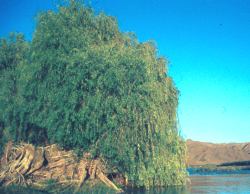Salix mucronata
Salix mucronata Thunb.
Family: Salicaceae
Common names: Safsaf Willow, Cape Willow, (E) Safsaf-wilger, Kaapse Wilger, Wildewilgerboom (A), Munengeledzi (V), Mogokare (NS), Umngcunube (X), Umnyezane, Umzekana (Z)
Introduction
A graceful tree that withstands both frost and drought.

Description
Description
This graceful semi-deciduous to evergreen tree grows up to 15 m with an open crown and slightly drooping branches. Older trees have fissured, brown bark, while younger trees have smooth, green-red bark. The leaves are simple, alternate and taper to both ends. They are glossy, dark green above and light green below. The leaf margins are serrated. Flowers appear in short spikes with males and females on separate trees. The male spikes are dense, yellowish and can be up to 50 mm in length. The greenish coloured female spikes are shorter and thicker. The fruit is a small capsule, which splits to release seeds covered with white fluff.
Conservation Status
Status
Salix mucronata is not threatened.
Distribution and habitat
Distribution description
The Safsaf Willow may be found growing along streams and riverbanks in much of the south east, south, and south west Cape, specifically along the Kei and Bashee Rivers, the Sundays River, the Fish River, the Breede River and the Groot and Klein Berg Rivers.

Ecology
Ecology
The Safsaf Willow is host to the larvae of the common orange and black butterfly.
Uses
Use
A good fodder tree, leaves are eaten by livestock and humans have developed various medicinal uses for the tree: Roots are used in medicines that help cure stomach pains, fever and headaches. Aspirin, for example, is a derivative of the willow species. Traditional uses include, applying bark powder to burns, and brewing tea from the leaves to treat rheumatism. The tea also acts as a mild laxative. Young tree branches are used to make baskets and the wood is carved to make household, as well as decorative items.
Growing Salix mucronata
Grow
Propagation is most rapidly achieved through cultivation of cuttings or truncheons, but seeds may be sown in trays filled with river sand.
The tree can withstand both frost and drought.
Plant Attributes:
Plant Type: Shrub, Tree
SA Distribution: Eastern Cape, Free State, Gauteng, KwaZulu-Natal, Limpopo, Mpumalanga, North West, Northern Cape, Western Cape
Soil type: Sandy, Loam
Flowering season:
PH: Acid, Neutral
Flower colour:
Aspect: Full Sun
Gardening skill: Easy
Special Features:
Horticultural zones











Rate this article
Article well written and informative
Rate this plant
Is this an interesting plant?
Login to add your Comment
Back to topNot registered yet? Click here to register.